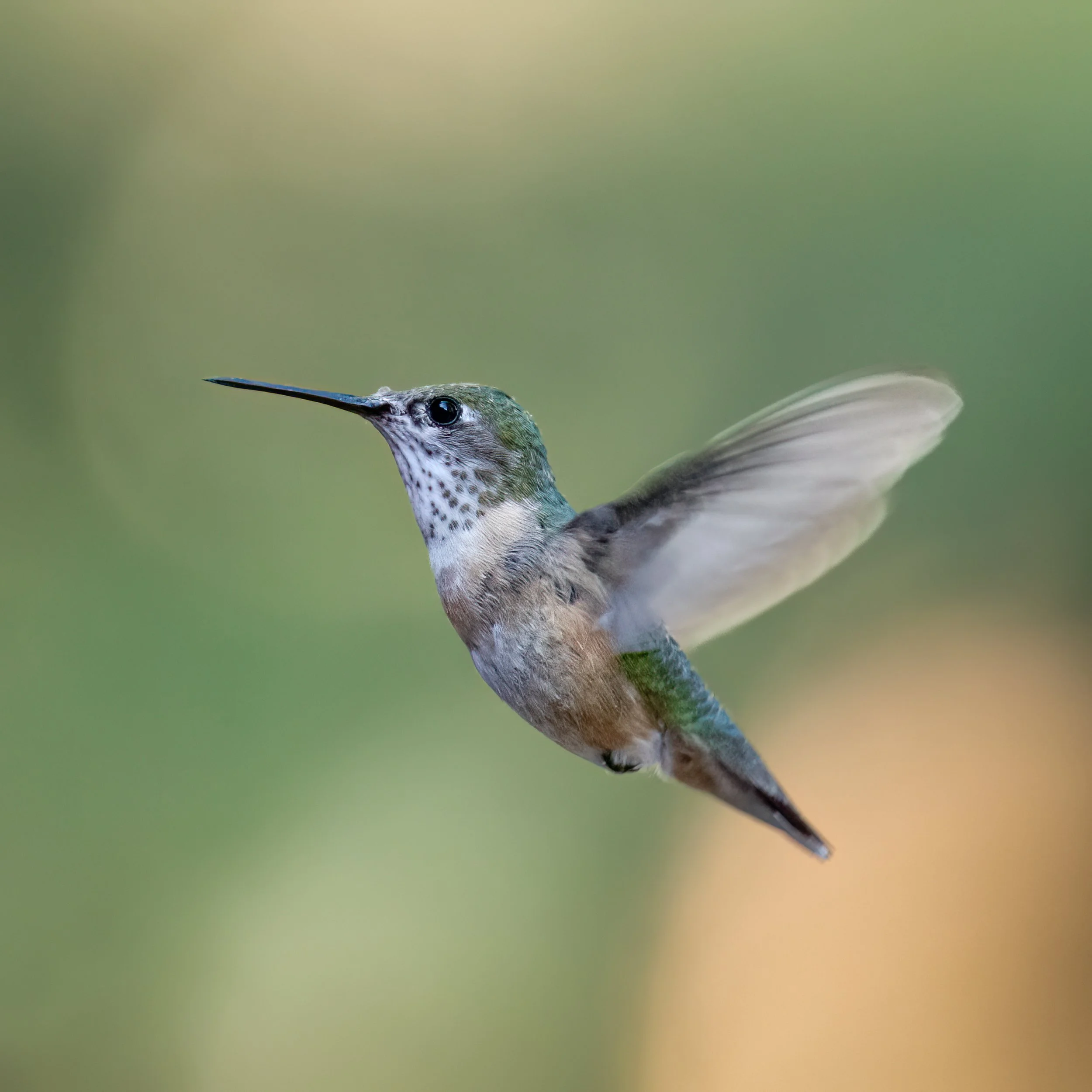Birds Around Me
Belted Kingfisher
The Belted Kingfisher is one of the few bird species in which the female is more brightly colored than the male.
Often heard before seen, this dagger-billed, shaggy-crested bird is usually spotted next to a river or lake or hovering over the water before plunging headfirst to snag a fish.
Belted Kingfishers nest in tunnels, which the birds excavate in a sandy bank, usually along a body of water. The tunnel, ranging from one to eight feet long, slopes upward from the entrance, probably to keep water from flooding the nest chamber where the female lays her eggs.
This bird's diet consists mostly of fish species that live in shallow water or swim near the surface, but Belted Kingfishers will also take crayfish, insects, frogs, snakes, young birds, and small mammals.
After capturing a small creature, the kingfisher returns to its perch and subdues its meal by pounding it against a hard surface. Then it positions the prey so that it is swallowed head-first. Like owls, adult kingfishers regurgitate pellets composed of indigestible parts of their meals, such as bones, shells, and scales.
Black-necked Stilts
Black-necked Stilts are among the most stately of the shorebirds, with long rose-pink legs, a long thin black bill, and elegant black-and-white plumage that make them immediately recognizable.
They have the second-longest legs in proportion to their bodies of any bird, exceeded only by flamingos.
The Black-necked Stilt can swim and dive if necessary, but prefers to wade in shallow water as it feeds, probing with its long, thin bill for insects and crustaceans on or near the surface of water. Other foods include many flies, beetles, and sometimes tadpoles or tiny fish.
Both parents incubate the eggs. On very hot days, stilts may soak their belly feathers to carry water to the nests, sometimes making more than a hundred trips a day to keep their eggs cool. The downy young leave the nest only an hour or two after hatching. They are tended to by both parents but feed themselves. They will take their first flight in about 4-5 weeks.
Black-necked stilts sometimes participate in a "popcorn display,” which involves a group of birds gathering around a ground predator and jumping, hopping, or flapping to drive it away from their nests.
Gray Jay
In 2016 the Gray Jay was designated as Canada’s National bird. Sometimes known as Whiskey Jack, it is found in every province and territory and has never been recorded outside of North America. Most of its range is in Canada, with only a small percentage crossing into Alaska and the western mountains of the United States. The species’ preferred habitat is Canada’s boreal and mountain forests.
In 2018, the American Ornithological Society voted to change the common name of the Gray Jay to Canada Jay.
These tough birds are unique for nesting as early as February, while the forests are still thick with snow, and have been recorded incubating eggs in snowstorms and at temperatures as cold as -30 C. The young leave nest at about 22-24 days and remain with parents for at least another month.
Canada Jays eat just about anything. They are opportunistic omnivores in their foraging, flying from tree to tree searching for food. They will attack rodents and small birds and regularly eat carrion, especially in winter, at kills left by wolves or other predators. Canada Jays are also found at feeders in their Northern range eating almost any kind of food (seeds, suet, etc.).
The Canada Jay stores large quantities of food for later use. It uses sticky saliva to glue small food items to tree branches above the height of the eventual snow line.
The Canada Jay has incredibly thick, fluffy plumage that it puffs up in cold weather, enveloping its legs and feet. Even its nostrils are covered with feathers.
They are important to Indigenous Peoples. The common moniker “whiskey jack” has nothing to do with the grain-based alcohols but is rather an anglicization of the Cree Wisakedjak and similar variations used by nations in the Algonquian language family, which makes the gray jay Canada’s only bird commonly referred to by a traditional Indigenous name.
Common Redpoll
One of the winter finches, nesting in the Arctic, Redpolls are tiny, restless birds, feeding actively on seeds among trees and weeds, fluttering and climbing about acrobatically, their flocks seemingly always on the move.
For their small size, they have a remarkable ability to survive cold temperatures; their southward flights are sparked by temporary scarcity of food in the North, not by cold. During winter, some Common Redpolls tunnel into the snow to stay warm during the night. Tunnels may be more than a foot long and 4 inches under the insulating snow.
Common Redpolls will quickly gather numerous whole seeds and store them in an expandable section of their throat called the diverticulum. Once they have flown to the safety of dense cover they will regurgitate the whole seed, husk it and then re-swallow the nut meat. This helps the bird in bitterly cold weather, allowing it to feed rapidly in the open and then digest food over a long period while it rests in a sheltered spot.
Common Redpolls eat seeds of a size to match their small bills. Their diet consists of mainly small seeds from birch, alder and spruce, and insects. A stand of winter weeds visited by a flock is a scene of feverish activity as they tear dried flower stalks apart and rush to the ground to pick up the seeds.
Globally, the population of the Common Redpoll is estimated to be in the millions.
Hairy Woodpecker
The Hairy Woodpecker is a medium-sized woodpecker with a squarish head, a long, straight, chisel-like bill, and stiff, long tail feathers to lean against on tree trunks. The bill is nearly the same length as the head which is one of the easiest ways to differentiate it from the smaller Downy.
Male and female Hairy Woodpeckers look almost exactly alike, but (as with the Downy) the male signals its gender with a red patch on the back of its head.
They eat mainly insects, mainly beetle larvae that live inside wood or tree bark as well as ants and caterpillars. Their long-barbed tongue and sticky, glue-like saliva help it to catch insects after pecking at trees and bushes. Hairy Woodpeckers are common visitors at feeders, eating suet and sunflower seeds.
Woodpeckers live where trees grow. Their preferred habitat is in open deciduous forests where trees such as poplars, birches and ash let the light in among the evergreens. Hairy Woodpeckers are common in mature woodlands with medium to large trees.
Pine Grosbeak
Female
Male
These big plump finches are uncommon but widespread in spruce and fir forests of the North and the high mountains. About the size of a Robin, it is a striking sight when it appears perched among snow-covered branches. They seem quite tame and do not immediately take flight when startled which can make them a fun bird to search for while bird watching.
Much of the year, the Pine Grosbeak primarily eats plant matter, including fruits, seeds, buds, and needles. Favored trees include mountain ash (rowan), crabapple, spruce, juniper, birch, and maple. In the summer, particularly while feeding young, this bird adds insects and spiders to its diet.
In the winter, Pine Grosbeaks can be found in small groups foraging for grit and salt along roadsides. They also visit backyard feeders for sunflower seeds and suet and will gather in flocks to eat spilled seed on the ground.
The amount of coloured plumage increases with age, too. Younger birds have less colouration, sometimes only the hood on their head and are obvious when seen side by side with fully decked out older birds.
They are an eruptive species and travel in substantial flocks, and so if you find them, you rarely see just one.
Pine Siskin
The Pine Siskins get their name from the coniferous trees that provide their food and habitat. They’ll hang upside down from the tips of branches, reaching into cones with their beaks to grab the nutritious seeds inside. These little birds are active and agile feeders and are frequently found eating small seeds from thistle plants and other trees. Aphids and other insects augment their summer diet.
Like most northern finches, they are also fond of salt, and can be found along highways that have been salted to melt snow. Pine Siskins become considerably plumper through accumulation of fat with the onset of winter. Each bird can pack enough seeds into its expandable esophagus (called the crop) to support itself through five hours of rest at minus 15º C temperatures.
Looking like a sparrow but in the finch family, pine siskins have small, slender bodies that are streaky brown all over, and especially on the chest. Bright yellow markings edge their wing tips and tails. This nomadic finch ranges widely and erratically across the continent each winter in response to seed crops.
Always gregarious, siskins often feed, roost, and nest in large flocks. Following a large irruptive winter flight, some individuals may stay near a dependable food source and breed far south of the normal breeding range.
Ruffed Grouse
Ruffed Grouse are the most widely distributed resident game bird in North America, living now or recently in all the Canadian Provinces and in 38 of the 49 states on the continent.
The Ruffed Grouse is a hearty, snow-loving, bud-eating bird which thrives during severe winters.
They are one of 10 species of grouse native to North America and are one of the smaller birds in the group. Ruffed Grouse are somewhat larger than pigeons, living their entire lives in wooded areas.
Ruffed Grouse can consume and digest large volumes of fibrous vegetation thanks to extra-long, paired pouches at the junction of the small and large intestines. They can also digest bitter, often toxic plants that many birds can’t handle. When the ground is bare of snow, Ruffed Grouse feed on a wide variety of green leaves and fruits, and some insects. They have also been known to eat snakes, frogs, and salamanders as well.
Seeing the secretive Ruffed Grouse can be quite difficult—although it can be easy to hear them when they are drumming. Once males leave the nest and establish their drumming log, they live in that area for their lives, generally travelling no further than a few hectares. The drumming sound is made by the male bird cupping his wings and rapidly beating them against the air, not his chest.
It is generally believed that the drumming warns other male grouse to keep away and attracts hens when they are ready for mating.
Red-breasted Nuthatches
Red-breasted Nuthatches are tiny, active birds of the north woods and western mountains. You will see these birds moving up and down trunks and branches of trees, many times upside down, searching for hidden insects. The young are fed almost entirely on insects and spiders.
Chopped nuts, seeds and suet readily attract nuthatches to feeders in winter and the birds often hoard this food, stuffing it into crevices in the bark of trees. They will then hammer against larger items to break apart.
The Red-breasted Nuthatch inhabits mixed-wood and coniferous regions, preferring spruce-fir forests.
They prefer to excavate their own nest cavities usually in dead or decaying wood. The birds then collect sticky pine resin to smear around the entrances, sometimes applying it with a piece of bark, a remarkable example of tool use. Both sexes coat the inside and outside of the nest hole entrance with this pitch that may help keep predators and competitors away.
Red-breasted nuthatches typically have one brood per season with 1-8 chicks. Nestlings stay in the nest for less than 2 weeks before fledging! They aren't on their own though, both parents will continue to care for the young and teach them throughout the summer.














